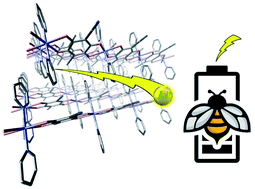Superior performance enabled by supramolecular interactions in metal−organic cathode: the power of weak bonds†
Abstract
Metal–organic-based electrode materials are increasingly appealing because both metal and organic linker are capable of undergoing redox processes, thus offering a high specific capacity. High porosity which can be achieved by the rational design of these materials is generally perceived as one of the major criteria for high rate performance. However, while Li-ion transport may be possible, oftentimes the counteranions (e.g., PF6−) and solvent molecules are co-inserted into the porous host lattice, potentially hindering Li-ion diffusion pathways. Here we propose the concept of close-packed metal–organic cathode stabilized by multiple supramolecular interactions as a viable solution for exceptional electrochemical performance. This is illustrated in a modularly designed redox-active [CuL(Py)2]n (LH4 = 1,4-dicyano-2,3,5,6-tetrahydroxybenzene, Py = pyridine). The mechanistic studies and DFT calculations confirm that the supramolecular interactions between its close-packed chains are the key to the flexible host lattice which only allows desolvated Li+ to intercalate, while these weak bonds also stabilize the inserted Li in the preferred hopping sites, creating optimal diffusion paths. The performance observed in this work is found to be among the best ever reported for metal–organic cathodes with a capacity as high as 255 mA h g−1 at 65 mA g−1 (0.25C) and a reversible capacity of 59 mA h g−1 at ∼26 A g−1 (100C) corresponding to 81% retention after 1000 cycles. These findings reveal a potential new strategy towards metal–organic-based electrodes with high performance and enhanced cycling stability.

- This article is part of the themed collections: 2023 Journal of Materials Chemistry A Lunar New Year collection and Journal of Materials Chemistry A Emerging Investigators


 Please wait while we load your content...
Please wait while we load your content...